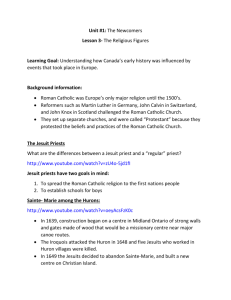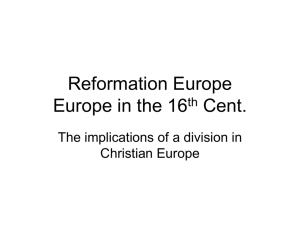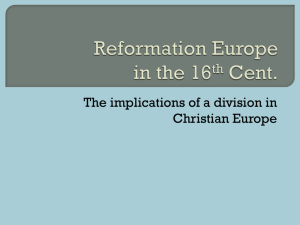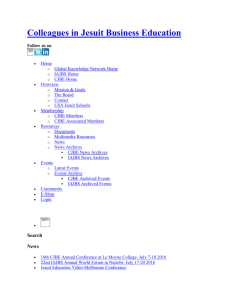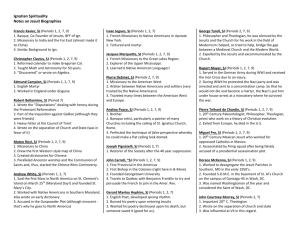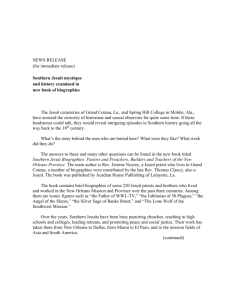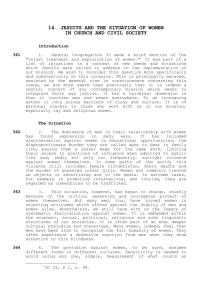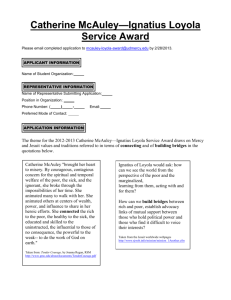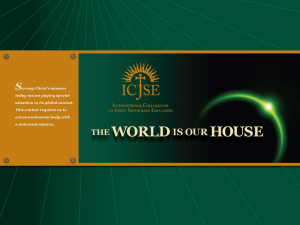Presentation
advertisement
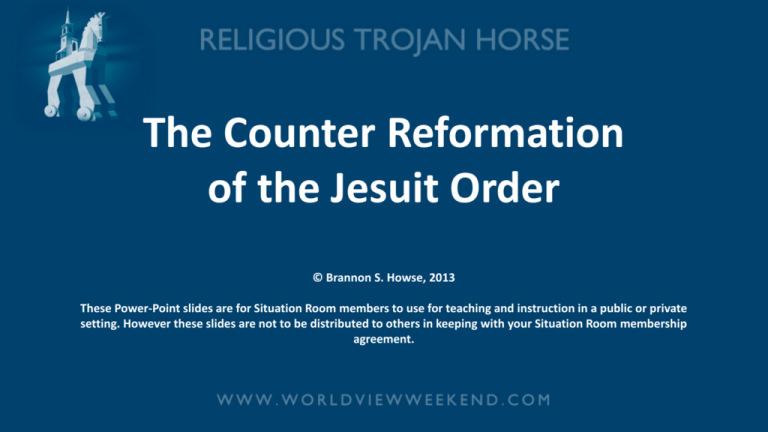
The Counter Reformation of the Jesuit Order © Brannon S. Howse, 2013 These Power-Point slides are for Situation Room members to use for teaching and instruction in a public or private setting. However these slides are not to be distributed to others in keeping with your Situation Room membership agreement. A Revived Holy Roman Empire? A covert group of EU foreign ministers has drawn up plans for merging the jobs currently done by Herman Van Rompuy, president of the European Council, and Jose Manuel Barroso, president of the European Commission. Source: express.co.uk “EU Plot to Scrap Britain” A Revived Holy Roman Empire? The new bureaucrat, who would not be directly elected by voters, is set to get sweeping control over the entire EU and force member countries into evergreater political and economic union. Source: express.co.uk “EU Plot to Scrap Britain” A Revived Holy Roman Empire? Opponents fear the plan could create a modern-day equivalent of the European emperor envisaged by Napoleon Bonaparte or a return to the Holy Roman Empire of Charlemagne that dominated Europe in the Dark Ages. A Revived Holy Roman Empire? Euro-PM Paul Nuttall, of the UK Independence Party said, “This is truly ridiculous idea that must never be allowed to happen. It sounds as if they are trying to go back to the days of the Holy Roman Emperor.” Nebuchadnezzar’s Dream 2:32, 38: Gold Head (Babylon) 2:32, 39: Chest & Arms of Silver (Medo-Persia) 2:32, 39: Belly & Thighs of Bronze (Greece) 2:33, 40: Legs of Iron (Roman Empire) 2:33, 41-43, Toes of Iron and Clay (Revived Roman Empire with Ten Federations) Charlemagne, Also known as Charles The Great was crowned Imperator Augustus by Pope Leo III on 25 December 800 in Rome. credit: Luc Viatour / www.Lucnix.be Nebuchadnezzar’s Dream 2:32, 38: Gold Head (Babylon) 2:32, 39: Chest & Arms of Silver (Medo-Persia) 2:32, 39: Belly & Thighs of Bronze (Greece) 2:33, 40: Legs of Iron (Roman Empire) 2:33, 41-43, Toes of Iron and Clay (Revived Roman Empire with Ten Federations) Daniel’s Vision of Four Beasts: 7:4: Lion with Wings (Babylon) 7:5: Bear raised on one side (Medo-Persia) 7:6: Leopard (Greece) 7:7: Fourth beast: (Roman Empire) 7:24: (Revived Roman Empire) Revelation 17:1-2: Then one of the seven angels who had the seven bowls came and talked with me, saying to me, “Come, I will show you the judgment of the great harlot who sits on many waters, with whom the kings of the earth committed fornication, and the inhabitants of the earth were made drunk with the wine of her fornication.” Revelation 17:3-4: And I saw a women sitting on a scarlet beast which was full of names of blasphemy, having seven heads and ten horns. The woman was arrayed in purple and scarlet, and adorned with gold and precious stones and pearls having in her hand a golden cup full of abominations and filthiness of her fornication. Revelation 17:9 reads: “The seven heads are seven hills on which the woman sits.” (City of Rome) Revelation 17:18: describes the woman that rides the beast as “the woman whom you saw is that great city which reigns over the kings of the earth.” (City of Rome) Revelation 17:12 The ten horns which you saw are ten kings who have received no kingdom as yet, but they receive authority for one hour as kings with the beast. Tony Blair Signing the EU Constitution Capitoline Hill, Rome, October 29, 2004 - before the bronze statue of Pope Innocent X (image: Associated Press) Ten Unions Now Being Discussed or Already in Existence Source: http://ec.europa.eu/world/where/index_en.htm North America Central America and Caribbean South America Western Europe Eastern Europe and Central Asia Mediterranean and Middle-East Africa North-East and South Asia South-East Asia Australia and Pacific The Euobserver.com 05/06/08 Australian Prime Minister Kevin Rudd has suggested that Asia and Pacific countries, including the region's heavyweights such as China, India and Japan, form a regional bloc similar to the European Union. The Euobserver.com reports that: The proposal is the latest in a long line of regional groupings modeled on the European Union. The African Union, a confederation of 53 African states was established in 2002, growing out of the earlier Organization of African Unity. Market Watch 1/28/09 On its face, while difficult to imagine, it makes intuitive sense. The ability to combine Canadian natural resources, American ingenuity and cheap Mexican labor would allow North America to compete better on a global stage. Gideon Rachman wrote a piece for the Financial Times on Dec. 8th, 2008: “And now for a world government.” I think the formation of some sort of world government is plausible.” A “world government” would involve much more than co-operation between nations. It would be an entity with state-like characteristics, backed by a body of laws. Financial Times on Dec. 8th, 2008: The European Union has already set up continental government for 27 countries, which would be a model. The EU has a supreme court, a currency, thousands of pages of law, a large civil service and the ability to deploy military force. So could the European model go global? There are three reasons for thinking that it might. Tragedy and Hope by Carroll Quigley Carroll Quigley: The power of financial capitalism had another far reaching plan, nothing less than to create a world system of financial control in private hands able to dominate the political system of each country and the economy of the world as a whole. This system was to be controlled in a feudalistic fashion by the central banks of the world acting in concert, by secret agreements arrived at in frequent meetings and conferences. The apex of the system was to be the Bank for International Settlements in Basle, Switzerland, a private bank owned and controlled by the world’s central banks, which were themselves private corporations. Each central bank, in the hands of men like Montagu Norman of the Bank of England, Benjamin Strong of the New York Federal Reserve Bank, Charles Rist of the Bank of France, and Hjalmar Schacht of the Reichsbank, sought to dominate its government by its ability to control treasury loans, to manipulate foreign exchanges, to influence The level of economic activity in the country, and to influence co-operative politicians by subsequent rewards in the business world. BIS Papers No. 17, Regional Currency Areas and the Use of Foreign Currencies reports: Given the high proportion of Canada and Mexico’s trade with the United States, a NAFTA dollar or ‘Amero’ has been proposed by some Canadian academics such as Grubel. Jean-Claude Trichet, President of the European Central Bank, April 26, 2010: The evolution of global governance: Let me turn to the question of how global governance is evolving after the crisis. Overall, the system is moving decisively genuine global governance that is much more inclusive, encompassing the key emerging economies as well as industrialized countries. The significant transformation of global governance that we are engineering today is illustrated by three examples. First, the emergence of the G20 a the prime group for global economic governance at the level of ministers, governors and heads of state or government. Secondly, the establishment of the Global Economy Meeting of central bank governors under the auspices of the BIS as the prime group for the governance of central bank cooperation. …the Global Economy Meeting (GEM), which gathers at the BIS headquarter in Basel. Over the past few years, this forum has included 31 governors as permanent members plus a number of other governors attending on a rotating basis. The GEM, in which all systemic emerging economies’ Central Bank governors are fully participating, has become the prime group for global governance among central banks. 1930, The New York Times article quoting Rep. Louis McFadden (chairman of the House Committee on Banking and Currency): The Federal Reserve Bank of New York is eager to enter into a close relationship with the Bank for International Settlements…The conclusion is impossible to escape that 1930, The New York Times article quoting Rep. Louis McFadden (chairman of the House Committee on Banking and Currency): the State and Treasury Departments are willing to pool the banking systems of Europe and America, setting up a world financial power independent of and above the Government of the United States… 1930, The New York Times article quoting Rep. Louis McFadden (chairman of the House Committee on Banking and Currency): The United States under present conditions will be transformed from the most active of manufacturing nations into a consuming and importing nation with a balance of trade against it. August 28th 1994, on ABC’s “This Week with David Brinkley”, commentator Cokie Roberts says: “Global bankers are really running the world.” On May 4, 1996, The Seattle Times publishes an article by syndicated columnist Alexander Cockburn in which he declares: …there is, in emerging outline, a world government composed of the International Monetary Fund and the central banks of leading industrial nations. National sovereignty is being eroded… 1996, The Confidence Game: How Unelected Central Bankers Are Governing the Changed Global Economy is published. The book was written by Steven Solomon, a former staff reporter for Forbes magazine. Ignatius Loyola (1491 – July 1556) April 23, 1973 TIME Magazine, April 23, 1973: Apart from their shared religious identity and their common appendage−S.J., for the Society of Jesus−they are a bewilderingly diverse fraternity. They are seismologists, swamis, architects and engineers, theologians and winemakers, politicians, lawyers, social workers, astronomers, evolutionaries, economists−as well as missionaries, teachers and parish priests. TIME Magazine, April 23, 1973: The−new Jesuit must still spend perhaps ten years in preparation, but he may live in fraternity-style surroundings in Berkeley, in Cambridge, Mass., or in Manhattan. TIME Magazine, April 23, 1973: Observed Catholic Journalist John Cogley in an accurate bit of doggerel in the Jesuit weekly America: " There are Jesuits young and old all across the spectrum of opinion. Observed Catholic Journalist John Cogley in an accurate bit of doggerel in the Jesuit weekly America: "There are Jesuits left and TIME Magazine, April 23, 1973: Jesuits right/ A pro and con for most any fight/ So wherever you stand, you stand not alone:/ Every little movement has a Jebbie of its own." Foxe’s Book of Martyrs Describes The Jesuits: The emperor Ferdinand, whose hatred of the Bohemian Protestants was without bounds, not thinking he had sufficiently oppressed them, instituted a high court to prosecute the reformers upon the plan of the Inquisition, with this difference, that the court was to travel from place to place and always to be attended by a body of troops. Foxe’s Book of Martyrs Describes The Jesuits: This court was conducted chiefly by Jesuits and from their decision there was no appeal, by which it may be easily conjectured that it was a dreadful tribunal indeed. Foxe’s Book of Martyrs Describes The Jesuits: This bloody court, attended by a body of troops, made the tour of Bohemia. They seldom examined or saw a prisoner, for the soldiers were permitted to murder the Protestants as they pleased and then to make a report of the matter to them afterward. Ceremony of Induction and Extreme Oath of the Jesuits The Jesuit Oath: I….Therefore, to the utmost of my power I shall and will defend this doctrine of his Holiness' right and custom against all usurpers of the heretical or Protestant authority… The Jesuit Oath: I do further declare that the doctrine of the churches of England and Scotland, of the Calvinists, Huguenots and others of the name Protestants or Liberals to be damnable and they themselves damned who will not forsake the same… The Jesuit Oath: I do further declare, that I will help, assist, and advise all or any of his Holiness' agents in any place wherever I shall be, in Switzerland, Germany, Holland, Denmark, Sweden, Norway, England, Ireland or America, or in any other Kingdom or territory I shall come to, and do my uttermost to extirpate the The Jesuit Oath: heretical Protestants or Liberals' doctrines and to destroy all their pretended powers, regal or otherwise. The Jesuit Oath: I furthermore promise and declare that I will, when opportunity present, make and wage relentless war, secretly or openly, against all heretics, Protestants and Liberals, as I am directed to do, to extirpate and exterminate them from the face of the whole earth; and that I will spare neither age, sex or condition; and The Jesuit Oath: that I will hang, waste, boil, flay, strangle and bury alive these infamous heretics, rip up the stomachs and wombs of their women and crush their infants' heads against the walls, in order to annihilate forever their execrable race. The Jesuit Oath: That when the same cannot be done openly, I will secretly use the poisoned cup, the strangulating cord, the steel of the poniard or the leaden bullet, regardless of the honor, rank, dignity, or authority of the person or persons, whatever may be their condition in life, either The Jesuit Oath: public or private, as I at any time may be directed so to do by any agent of the Pope or Superior of the Brotherhood of the Holy Faith, of the Society of Jesus. The Jesuit Oath: In confirmation of which, I hereby dedicate my life, my soul and all my corporal powers, and with this dagger which I now receive, I will subscribe my name written in my own blood, in testimony thereof; and should I prove false or weaken in my determination, may my brethren and fellow soldiers of the Militia of The Jesuit Oath: the Pope cut off my hands and my feet, and my throat from ear to ear, my belly opened and sulphur burned therein, with all the punishment that can be inflicted upon me on earth and my soul be tortured by demons in an eternal hell forever! One of The Jesuits’ Main Tool For Accomplishing Their Goals is the Hegelian Dialectic Process Former Jesuit Malachi Martin wrote in his 1987, New York Times Best-Seller “The Jesuits” that Francis Carney, a prominent Jesuit of the 1970s regarded “dialectical conflict” as that which should be “treasured as the key to the future of Catholicism.” source: The Jesuits by Malachi Martin, p. 20. The Jesuits Main Focus is: 1. Ecumenicalism 2. Social Justice/Liberation Theology 3. Dominion Theology 4. Politics, Community Organizing & Revolution The Jesuits Main Focus is: 5. Education 6. The Press 7. The Pulpit and Denominations 8. Mysticism 1. Ecumenicalism TIME Magazine, April 23, 1973: Contemporary Jesuit theologians, for instance, helped shape the Second Vatican Council. The Second Vatican Council Was Held From 1962-1965 and Was Instrumental in Propelling the Ecumenical Movement (Picture is Opening of Second Session of Vatican II, 1963.) Catholic Edition – Only available from Ignatius Press Foreword by Fr. Joseph Fessio, SJ On March 29, 1994 Evangelicals and Catholics Signed the Declaration “Evangelicals and Catholics Together: The Christian mission in the 3rd Millennium The New York Times March 30, 1994: They toiled together in the movements against abortion and pornography, and now leading Catholics and evangelicals are asking their flocks for a remarkable leap of faith: to finally accept each other as Christians. In what's being called a historic declaration, evangelicals including Pat Robertson and Charles Colson joined with conservative Roman Catholic leaders today in ... urging Catholics and evangelicals ... to stop aggressive proselytization of each other's flocks. John White, president of Geneva College and former president of the National Association of Evangelicals, said the statement represents a "triumphalistic moment" in American religious life after centuries of distrust.... 1994 Evangelicals and Catholics Together Document Stated in Part: In the exercise of these public responsibilities there has been in recent years a growing convergence and cooperation between Evangelicals and Catholics. We thank God for the discovery of one another in contending for a common cause. Much more important, we thank God for the discovery of one another as brothers and sisters in Christ. Our cooperation as citizens is animated by our convergence as Christians. We promise one another that we will work to deepen, build upon, and expand this pattern of convergence and cooperation. 1994 Evangelicals and Catholics Together Document Stated in Part: …in view of the large number of non- Christians in the world and the enormous challenge of our common evangelistic task, it is neither theologically legitimate nor a prudent use of resources for one Christian community to proselytize among active adherents of another Christian community. 2. Social Justice/Liberation Theology The term social justice was coined by Jesuit Luigi Taparelli in 1840 In the Protestant world social justice is also called the social gospel Catholicnewsagency.com November 20, 2008 Headline: Jesuit Superior General says give more time to Liberation Theology Jesuit Superior General says give more time to Liberation Theology: “The Superior General of the Jesuits, Father Adolfo Nicolas, said this week he was disappointed that Liberation Theology has not received a ‘vote of confidence’ and he said the controversial approach should be given more time to mature.” The Society of Jesus in the United States Website, Jesuit.org reported in 2012: Circle of Protection from Poverty — Very Rev. Tom Smolich, S.J., President of the Jesuit Conference, has signed on as a “primary signatory” to a new ecumenical and interfaith “Circle of Protection” Statement urging the Federal Government to protect programs for the poor Former Jesuit Malachi Martin Wrote in his 1987 Best Seller “The Jesuits”: “Francis Carney, SJ…if not the most famous or influential of all modern Jesuit Liberation theologians…Drunk on the ignorance-laden idealism of Liberation Theologians, this Jesuit came to the belief that ‘a Marxist is not dogmatic, but dialectical.” Francis Carney, Jesuit Priest: “Neither communists nor capitalist…,” the new socialism will be “a brotherhood and sisterhood of all humanity…and equally a classless society…” Theologically speaking, “the universe of man is in dialectical evolution towards the Kingdom of God…” In June of 2009 in His 30,000 Word Encyclical Pope Benedict XVI Declared: …In this way it will be possible to experience and to steer the globalization of humanity in relational terms, in terms of communion and the sharing of goods. In June of 2009 in His 30,000 Word Encyclical Pope Benedict XVI Declared: The more we strive to secure a common good corresponding to the real needs of our neighbors, the more effectively we love them. Vatican Calls For “Central World Bank” In October of 2011 the Vatican released an 18 page report that called for a "global public authority" and a "central world bank" and "a supranational authority" with "universal jurisdiction". The 18 page document released by the Vatican contained the often used communitarian phrase “common good” twenty-two times. 3. Dominion Theology Georgetown University Seal (A Jesuit University) The seal of Georgetown University. It bears the founding date, 1789, the university motto "Utraque Unum" (both into one) The Preterist View of Bible Prophecy Was Developed by Louis of Alcazar) (1554– 1613) a Spanish Jesuit theologian 4. Politics, Community Organizing & Revolution In June of 2009 in His 30,000 Word Encyclical Pope Benedict XVI Declared: To manage the global economy … to bring about integral and timely disarmament, food security and peace; to guarantee the protection of the environment and to regulate migration: for all this, there is urgent need of a true world political authority. A 2011, Chicagomag.com article by Daniel Libit Reported: It has now been more than four years since Barack Obama threw an arm around Gregory Galluzzo in Iowa and confided that whenever anybody asked how his presidential campaign had so quickly assembled its grass-roots operation, he would credit Galluzzo’s mentorship. A former Jesuit priest who’d been drawn to Chicago by the work of Saul Alinsky, the father of community organizing, Galluzzo had good reason to feel proud: He was indirectly responsible for bringing young Barack Obama to Chicago to be an organizer. Obama’s subsequent election was “like a son winning an office,” says Galluzzo. Article title: The End of Community Organizing in Chicago? James Aitken Wylie on the Jesuits Using Communism For Revolution, Compliance, and Punishment If these governments will return to their obedience to the See of Rome, the Jesuits will exert themselves to the utmost to extinguish Communism, and make all safe and stable around the thrones which it menaces with overthrow. (p. 102) James Aitken Wylie on the Jesuits Using Communism For Revolution, Compliance, and Punishment But if these governments shall maintain their present attitude to the Vatican, if they persist in declining the Concordats and canon law of Rome, they will be left to reckon with the Communists as best they may. Help from the Papal See they shall have none. Nay, the Jesuits in the end of the day, will make common cause with Communism, and will use this new-sprung force (p. 102) James Aitken Wylie on the Jesuits Using Communism For Revolution, Compliance, and Punishment to wreak their vengeance on those Governments which have lifted up the heel against their liege lord, and obstinately refuse to return to their obedience to a ruler who claims to be the moral and political sovereign of all Christendom, the king of all its kings. (p. 103) James Aitken Wylie on the Jesuits Using Communism For Revolution, Compliance, and Punishment They are working all round Europe to bring on confusion, not doubting for a moment that out of this chaos will emerge their long cherished dream of a Universal Catholic Monarchy. (p. 103) 5. Education A Must Read Former Jesuit Malachi Martin in his New York Times Best Seller “The Jesuits” wrote: They had a monopoly in the education of Europe for over two hundred years, and numbered the famous and infamous in their worldwide alumni – Voltaire, Luis Bunuel, Fidel Castro, and Alfred Hitchcock included. James Aitken Wylie The plan pursued by the Jesuits was the following. Their best men they sent to the university seats, and colleges…They established small detachments of their order in the chief cities, and there they opened pretentious seminaries. The rest they distributed as schoolmasters over the country districts. (p. 43) James Aitken Wylie They professed a boundless zeal for education, and gave themselves out as experts in the art. Their aim was to draw the youth, and especially the sons of Protestants, into their schools. In this they succeeded. They took care to have a few brilliant examples of their teaching ready for display… (p. 43) James Aitken Wylie They meant no harm, the Jesuits said, by teaching their Protestant pupils these innocent arts. Perhaps so; but in twenty years the sons had forsaken the faith of their fathers, and a new race of Romanists had risen up in the German Fatherland. (p. 44) 6. The Press James Aitken Wylie The press of Great Britain is already manipulated by them to an extent of which the public but little dream. Not a few newspapers have a Jesuit on their staff as editor, or “contributor,” or “reporter.” The reporting force of the kingdom is, to a considerable extent, made up of Romanists…a newspaper may James Aiken Wylie unaware to itself often, be influenced against a cause, or an individual obnoxious to Rome, although it may have no Romanists in its service. There are names the Times dare not mention; there are causes, true and noble it dare not advocate. (p. 93) James Aiken Wylie The whole English press of the world is supervised, and the word is passed round how writers, speakers, and causes are to be handled, so that everywhere its verdict may be the same, and applause or condemnation dealt out just as it may accord with the interests and wishes of Rome. (p. 94) 7. The Pulpit and Denominations James Aiken Wylie on Jesuits Infiltrating the Protestant Pulpits: They will do their best to sink the differences betwixt Popery and Protestantism, and to show that the Reformers misunderstood the teachings of Rome, at least exaggerated her errors, and so mislead the people; in short, that there is no question touching matters of saving import at issue between the two Churches, James Aiken Wylie on Jesuits Infiltrating the Protestant Pulpits: and no reason, did charity but more abound, why the two should not again be one. Moreover, they will preach what to the uninstructed Protestant will appear Protestantism, and even Calvinism. There is nothing to hinder a Romish priest, proceeding on the lines of the Council of Trent, preaching the doctrine of justification James Aiken Wylie on Jesuits Infiltrating the Protestant Pulpits: by faith. He does not need a dispensation from the Pope to do so. And thousands will not know the difference, but will believe the Popish doctrine to be the same with the teachings of Paul and of Luther, while all the while the two are essentially and eternally antagonistic. (p. 100) 8.Mysticism TIME Magazine, April 23, 1973: Mystics…a band of mystics who chose to find their enlightenment in a combative encounter with the world around them. Former Jesuit Malachi Martin in his book “The Jesuits” wrote: They [Jesuits] advanced the study of asceticism and mysticism…They brought back to Europe the first acquaintance Western men got of Indian and Chinese culture. They translated the Sanskrit Vedas. (p. 29) Edmond Paris: Author of Secret History of the Jesuits By their clever maneuvers and dialectics they succeeded in defeating the opposition and all “heretic” claims… Jesuit and “Father of the New Age Movement” Teilbard de Chardin said: “The fate of mankind, as well as of religion, depends upon the emergence of a new faith in the future.” Mathew 24:33 Even so, when you see all these things, you know that it is near, right at the door.
